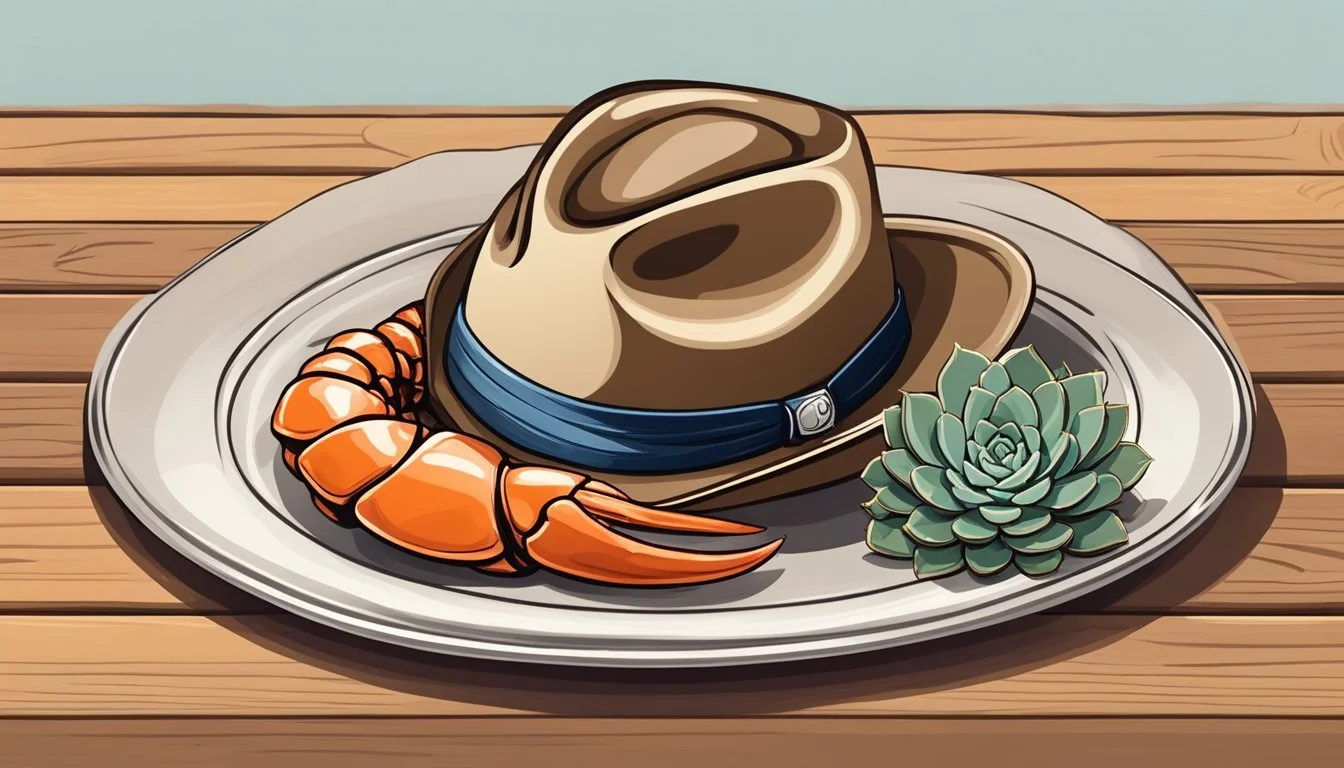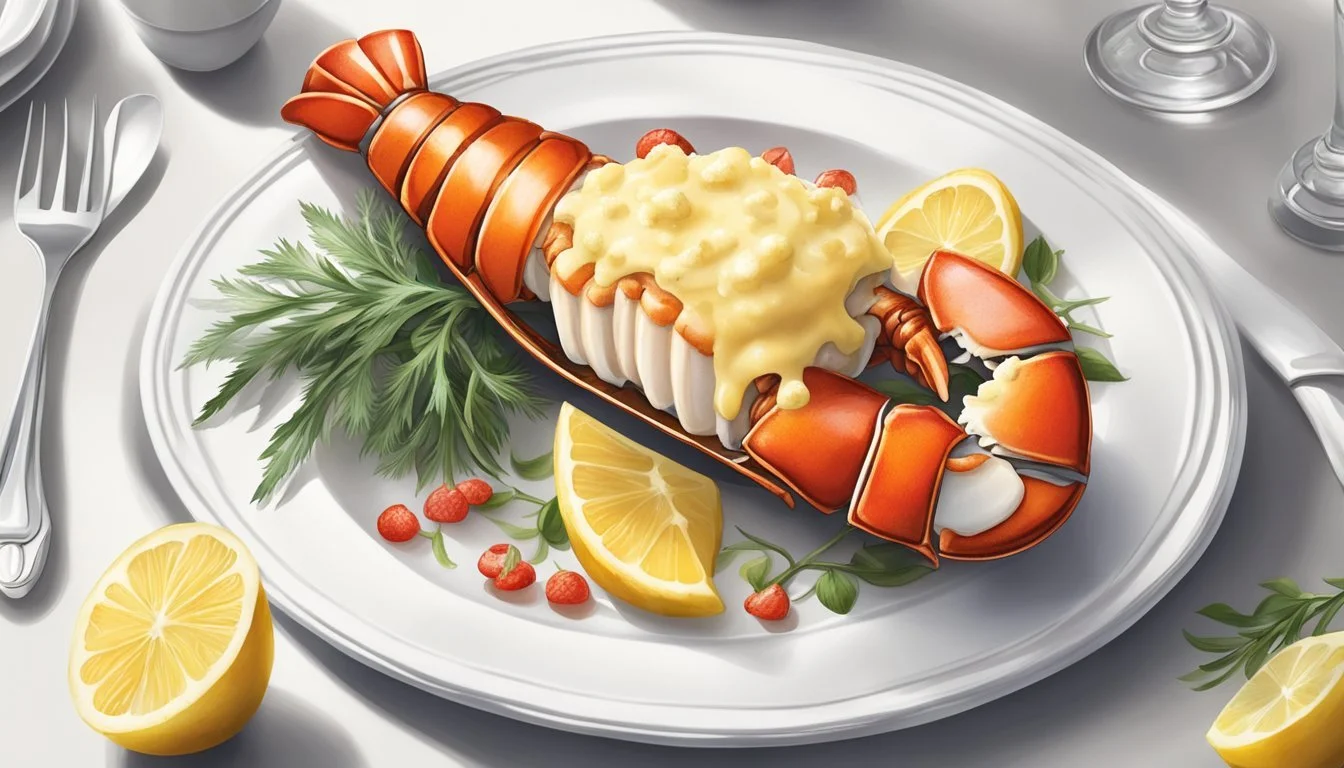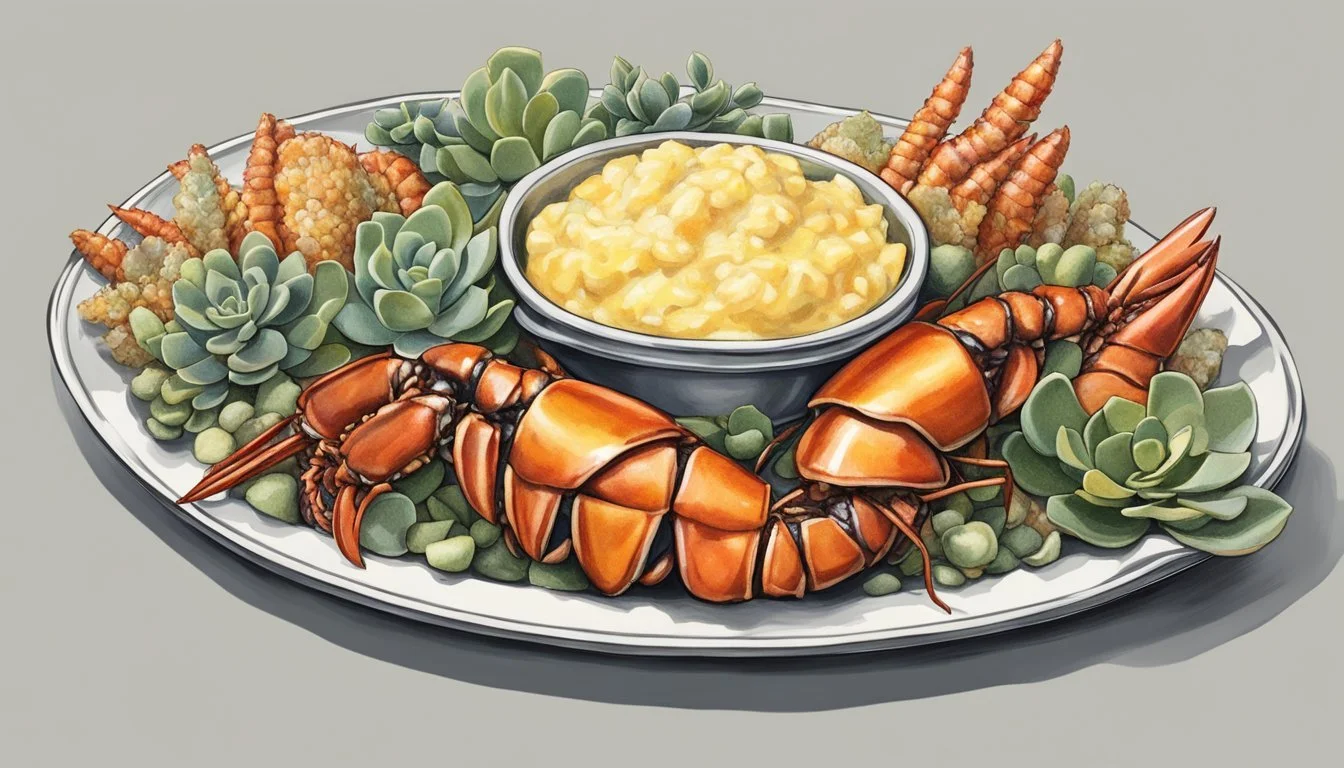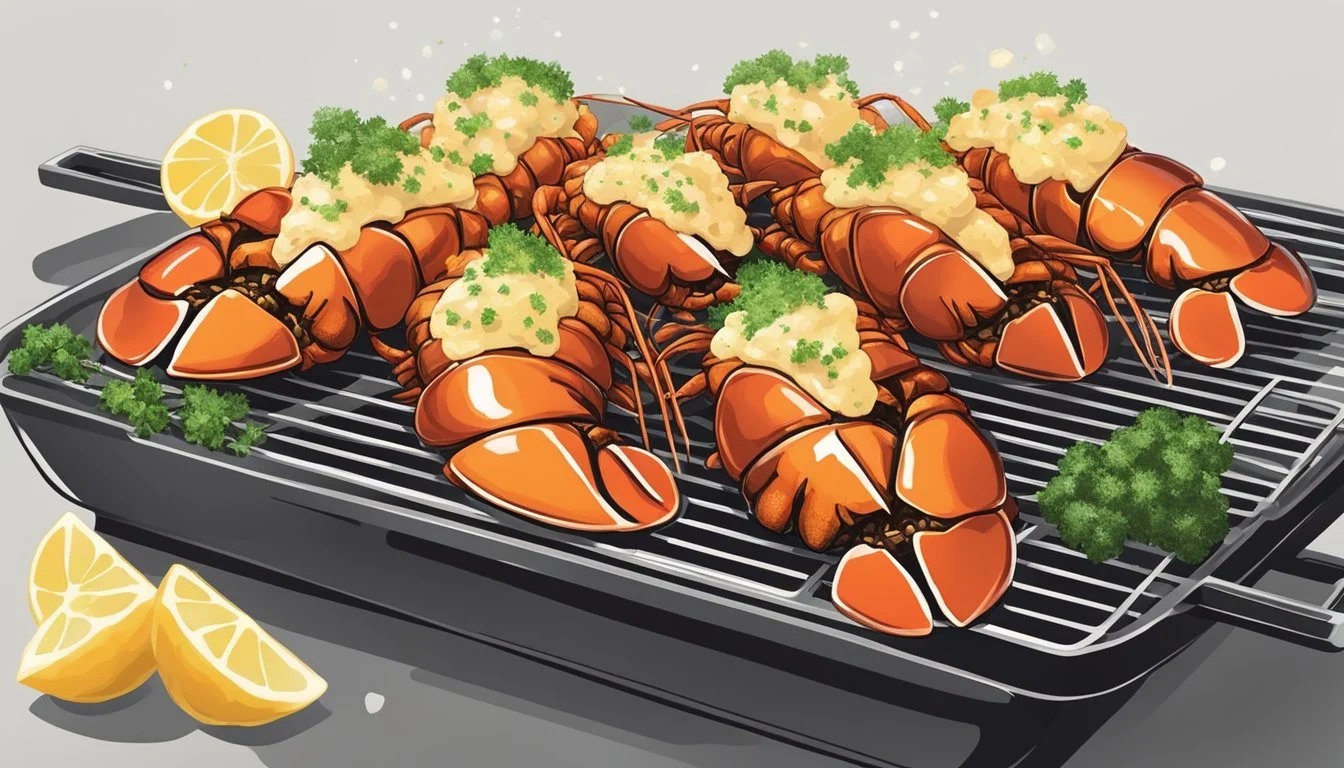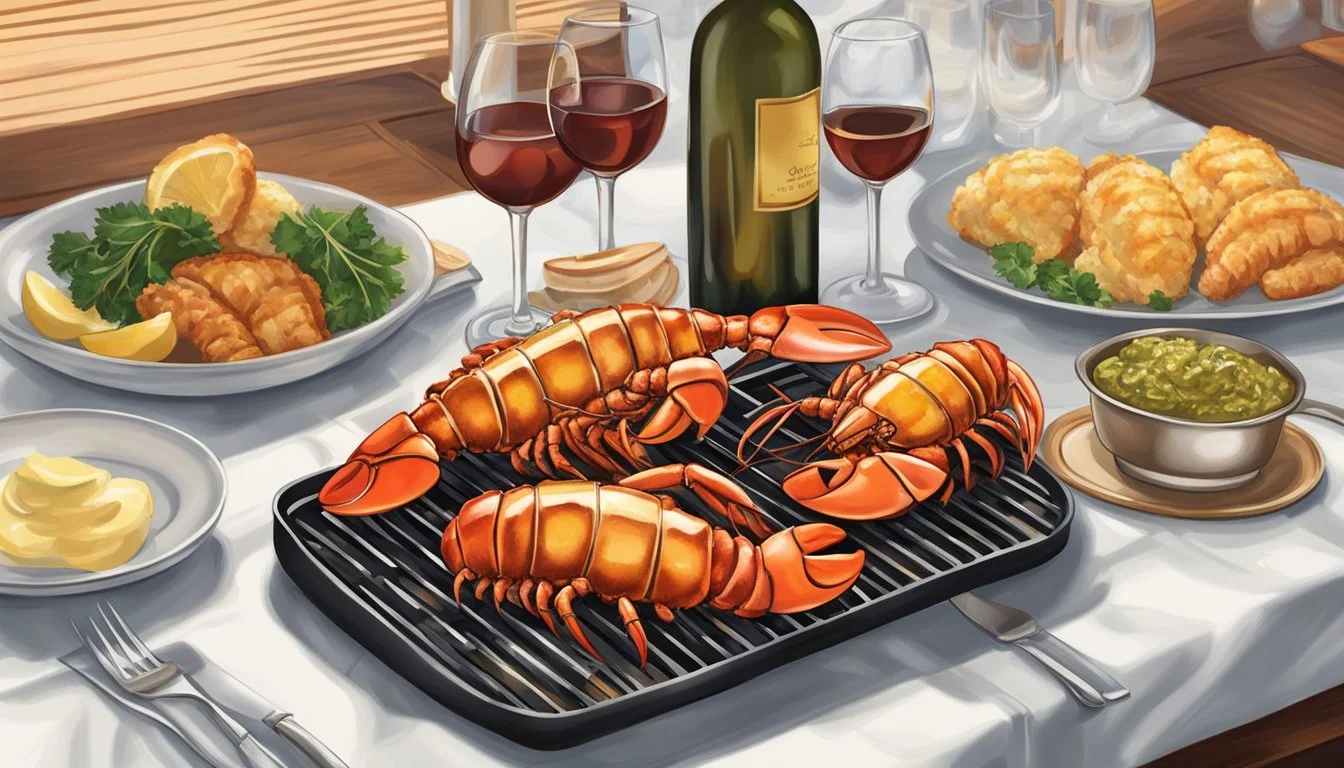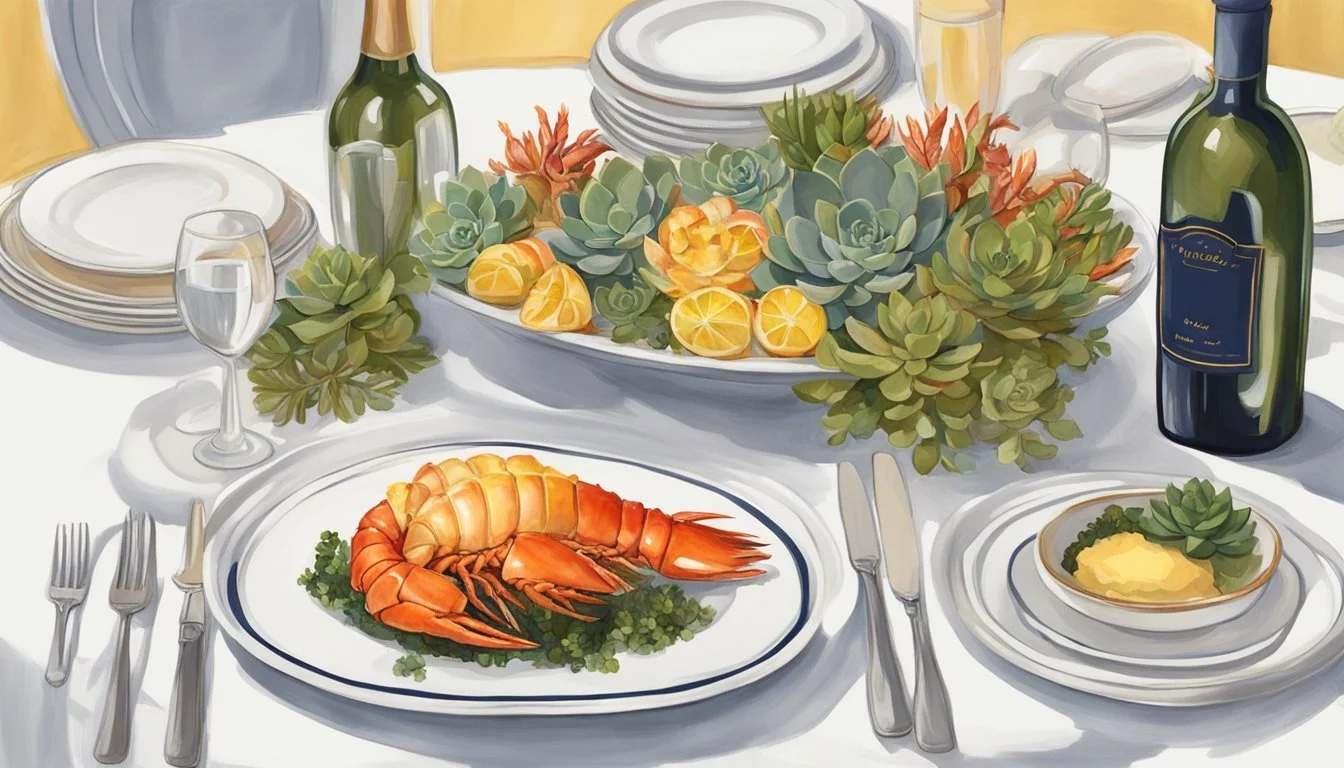Cowboy Butter Lobster Tails
A Guide to Mastering This Gourmet Dish
Cowboy Butter Lobster (What wine goes well with lobster?) Tails epitomize a culinary masterpiece that elevates the dining experience for special occasions. Cowboy Butter, a sumptuous blend of rich butter and a medley of herbs and spices, complements the sweet, succulent flesh of lobster tails to create an entrée that is both elegant and flavorful. The combination of garlic, parsley, chives, and a hint of citrus from lemon harmoniously melds with the mild seafood, delivering a dish that is sophisticated yet approachable.
Preparing lobster tails with Cowboy Butter is more than just a meal; it's a celebration of flavors that turns a regular dinner into an extraordinary event. The process of gently cooking these lobster tails, whether by grilling or baking, primes them for a luxurious bath in the infused butter, ensuring that every bite is infused with delicious complexity. This dish requires precision and care, but the final presentation is stunning, making it an ideal choice for impressing guests or adding a touch of indulgence to a special occasion meal.
Recognized for its impressive visual appeal and robust taste profile, the preparation of Cowboy Butter Lobster Tails is as delightful to craft as it is to consume. Chefs and home cooks alike relish the simplicity of enhancing the natural beauty of lobster with a decadent sauce that is at once comforting and exotic. This entrée stands as a testament to the harmony of land and sea, offering a balanced, confident composition that is sure to have diners savoring every morsel.
Understanding Cowboy Butter
Cowboy Butter is a rich and flavor-packed compound butter that elevates simple dishes to gourmet levels. It combines the robustness of spices and herbs with the creamy texture of butter.
Origins of Cowboy Butter
Cowboy Butter has its roots in American culinary tradition, echoing the bold flavors favored by cooks of the American West. It’s often paired with grilled meats and seafood, providing an additional layer of flavor to classic barbeque fare.
Key Ingredients
The key components of Cowboy Butter include:
Butter: The foundation, providing a creamy base.
Garlic: Gives a strong, aromatic flavor.
Lemon: Adds brightness and acidity.
Parsley: Offers a fresh, herbaceous note.
Chili and Cayenne: Introduce a spicy kick.
Chives: Contribute a mild onion-like taste.
These ingredients can be adjusted in proportion to tailor the heat and herbaceousness to one's preference.
Flavor Profile
Cowboy Butter is a complex blend that creates a multifaceted taste sensation:
Savory: From garlic and butter.
Spicy: Through chili and cayenne.
Citrusy: With the zing of lemon.
Herbaceous: Thanks to parsley and chives.
This signature sauce serves not only as a flavorful baste for cooking but also doubles as a dip for a multitude of dishes.
Selecting Quality Lobster Tails
When preparing Cowboy Butter Lobster Tails, selecting high-quality lobster is crucial. The choice between fresh and frozen lobster tails affects flavor and texture, and knowing how to spot freshness ensures an elegant and impressive entrée.
Fresh vs Frozen Lobster Tails
Fresh Lobster Tails: They are often preferred for their superior taste and texture. However, their availability is dependent on geographical location and season. Freshness can be gauged by the lobster tail's firmness and a mild sea breeze scent.
Pros: Optimal texture and flavor; fewer preservatives.
Cons: Limited availability; higher price.
Frozen Lobster Tails: They offer convenience and year-round availability. Flash-freezing techniques can lock in quality effectively if done immediately after catch.
Pros: Easy to store; wider availability.
Cons: Can lose texture; must thaw properly to prevent toughness.
How to Spot Fresh Lobster
Examining a lobster's tail is key to spotting its freshness. For live lobster at a seafood store or fish market:
Appearance: The tail should curl under the body tightly when lifted, indicating liveliness.
Shell: Look for a shiny shell without any discoloration or cracks.
For fresh lobster tails (not live):
Smell: There should be a fresh, briny scent, not a strong fishy odor.
Color: The flesh should be a translucent white with no signs of yellowing or drying.
Where to Purchase Lobster Tails
Seafood markets or specialty stores often provide the freshest options for live and fresh lobster tails. Supermarkets may have a seafood section, but the freshness may vary.
Local Markets: Seek out nearby fish markets with a reputation for fresh seafood.
Supermarkets: Some large chains keep a stock of frozen lobster tails. Check for a solid freeze with no freezer burn.
Online Retailers: A convenient option for those without local access to fresh seafood, with the capability to deliver fresh or frozen lobster tails directly to your door.
Purchasing lobster tails from reputable sources ensures the quality of your dinner and the success of your Cowboy Butter Lobster Tail dish.
Preparation Essentials
The key to a splendid cowboy butter lobster tail dish lies in meticulously readying the ingredients and tools. Proper preparation not only ensures a delectable outcome but also maintains the safety and ease of the cooking process.
Kitchen Tools Needed
Cutting Board & Knife: For cutting lobster tails and lemon wedges.
Kitchen Shears: Essential for butterflying the lobster tails.
Baking Sheet: Used to roast the lobster tails in the oven.
Whisk: Needed to blend the cowboy butter ingredients smoothly.
Meat Thermometer: Ensures the lobster is cooked to perfection.
Small Bowls: For holding ingredients like lemon juice and seasoning.
Prepping the Lobster Tails
To prepare lobster tails, one should
Thoroughly defrost them if frozen, which takes about 18-24 hours in the refrigerator.
Use kitchen shears to cut the top shell lengthwise to butterfly the lobster tails, then lift the meat slightly to rest on top of the shell.
Season the meat with salt, pepper, and apply the homemade cowboy butter mixture.
Slice a lemon wedge for garnishing and additional flavoring once served.
Safety Tips
When handling lobster tails:
Ensure the cutting board is stable.
Keep your hands dry to maintain a good grip on the knife and shears.
Always point the knife away from oneself when cutting the lemon wedges or any ingredients.
Monitor the internal temperature with a meat thermometer, looking for the safe minimum of 140°F to prevent undercooking.
Cooking Techniques
In preparing Cowboy Butter Lobster Tails, one must employ precise cooking methods to achieve the dish's signature taste and texture. Each technique varies slightly in execution, ensuring the lobster tails reach the ideal internal temperature without overcooking.
Baking Lobster Tails
For baking, one preheats the oven to a specific temperature, often between 350°F to 375°F. Lobster tails are usually butterflied and placed in a baking dish. The duration typically ranges from 12-15 minutes depending on size, aiming for an internal temperature of around 140°F to ensure they are cooked through.
Broiling Lobster Tails
Broiling involves higher heat from the oven's top element. One should adjust the oven rack so the lobster tails are about 10 inches from the broiler. Broil times vary, usually 1-2 minutes per ounce of individual tail weight. The tails should exhibit a lightly charred appearance and reach the appropriate internal temperature.
On the Grill
Grilling lobster tails infuses them with a subtle smokiness. One should preheat the grill to a medium-high heat and place the tails meat side down initially, then flipping once. The tails typically require 5-7 minutes on each side. Constant attention is necessary to prevent overcooking while striving for that critical internal temperature mark.
Crafting the Cowboy Butter Sauce
Cowboy Butter Sauce is intrinsic to elevating the flavors of lobster tails. The sauce's rich and tangy profile is crafted through the careful blending of high-quality ingredients and precise heating techniques.
Combining the Ingredients
In making the Cowboy Butter Sauce, the preparer starts by acquiring unsalted butter, which provides control over the saltiness of the final sauce. One must allow the butter to reach a melted state without letting it brown, ensuring it is ready to incorporate other flavors. Meticulousness is key when adding lemon juice, as it infuses a vibrant citrus dimension.
Ingredients Quantity Unsalted Butter 1 cup (melted) Lemon Juice 2 Tbsp Garlic 2 Tbsp (minced) Parsley 1/4 cup (chopped) Paprika 1 tsp Salt To taste Pepper To taste
A fine balance of spices is essential, so generous amounts of garlic, freshly minced, followed by parsley for a subtle herbal touch, paprika for a mild heat and smokiness, and seasonings such as salt and pepper are incorporated. One could also consider a small amount of garlic powder for a more complex garlic profile. The ingredients are then whisked together vigorously to create a homogeneous mixture.
Proper Heating and Usage
The Cowboy Butter Sauce, once its ingredients are blended, requires gentle heat to become its best self. The cook should employ low heat to ensure the sauce's temperature is just enough to meld the flavors but never high enough to cause separation or burning.
For usage, the sauce is versatile: it can serve as a dipping sauce, a brush-on glaze for grilling the lobster tails, or a pour-over enhancement for the finished plate. If the sauce is to be stored for later, one simply places it in an airtight container and refrigerates. To use it after its been set, reheating must be as cautious as the initial heating, stirring constantly over a low flame to preserve the emulsion.
Serving and Presentation
When presenting Cowboy Butter Lobster Tails, the dish transforms from a mere meal to a culinary experience. The vibrant lobster meat becomes the centerpiece, enhanced by golden cowboy butter and elegant garnishes.
Assembling the Dish
To assemble Cowboy Butter Lobster Tails, one should place the cooked lobster tails on a warm plate. It's essential to drizzle the cowboy butter generously over the succulent lobster meat, ensuring it pools around the shell for added flavor and visual appeal. For an artistic touch, garnish with fresh parsley, providing a dash of color contrast against the red shell and white meat. (What wine goes well with white meat?)
Lobster Meat: Should be placed centrally on the plate.
Cowboy Butter: Generously spooned over the lobster.
Fresh Parsley: Sprinkled atop for a fresh look.
Accompaniments
Choosing the right side dishes can complement the richness of the lobster tails. Here's a concise list of recommended sides:
Salad: A light, greens-based salad balances the buttery lobster.
Mashed Potatoes: Creamy and smooth, these provide a comforting base.
Mac and Cheese: For an indulgent side, pair with a rich, cheese-coated pasta.
Steak: Adding a steak creates a luxurious surf-and-turf option.
Each side should be plated in a way that supports the lobster as the star of the show.
Serving Suggestions
Cowboy Butter Lobster Tails are best served immediately after plating to maintain the ideal temperature and texture. For an extra touch of elegance, include a lemon wedge on the side of the plate for guests to squeeze over their lobster tail if desired. It's ideal to serve the lobster with tools for cracking and retrieving the meat from the shell, as well as an extra dish for discarded shells. Offering warm, damp cloths or hand wipes can be a thoughtful touch for guests after they've indulged in this hands-on entrée.
Health and Nutrition
Lobster tails are a popular seafood choice known for their delicate flavor and texture. When considering their nutritional composition, they offer a high-protein and low-carbohydrate profile, making them a suitable option for those seeking balanced nutrition. Lobster meat is also a good source of omega-3 fatty acids, which contribute to heart health and possess anti-inflammatory properties.
However, the nutritional benefits of lobster can be affected by the preparation method. Traditional cowboy butter sauce, a rich combination usually consisting of butter, garlic, and herbs, can add a significant amount of fat to the dish. While garlic lends a pungent flavor and health benefits, such as reducing blood pressure and improving cholesterol levels, the quantity of butter may contribute to an increase in calorie and fat intake.
Nutritional Overview:
Protein: Lobster tails are high in protein, essential for muscle repair and growth.
Carbohydrates: Minimal in lobster, making it a low-carb option.
Fats: The butter sauce increases the fat content, specifically saturated fats.
Given the considerations, one can modify the butter sauce to align better with nutritional goals. Using less butter or substituting with a lighter alternative can reduce caloric intake while maintaining flavor. Including herbs like parsley enhances flavor and can also add a dose of vitamins and antioxidants.
In summary, lobster tails are a nutritious seafood choice. By being mindful of the sauce preparation, one can enjoy this elegant entrée with health benefits intact.
Storing Leftovers
Proper storage of cowboy butter lobster tails is crucial to maintaining their quality and safety. The following techniques ensure that the lobster retains its flavor and texture when refrigerated or frozen, and provide the best methods for reheating leftovers.
Refrigeration Techniques
For refrigeration, the lobster should be stored in an airtight container to prevent contamination and odor absorption from other foods. Place the lobster in the container as soon as it has cooled to room temperature.
Lobster should be consumed within two days when refrigerated.
Freezing Tips
Freezing lobster tails is an option if they cannot be consumed immediately. For optimal texture, wrap the lobster tightly in plastic wrap or aluminum foil before placing it in an airtight container or freezer bag.
Label with the current date; lobster is best used within three months to prevent freezer burn.
Reheating Leftovers
The key to reheating lobster is to do so gently to preserve its delicate texture.
When reheating lobster in the oven, set it to a low temperature (around 275°F) and add a splash of water or broth to the dish to keep the lobster moist.
Alternatively, lobster can be reheated in a skillet over low heat with a bit of butter or the original cowboy butter sauce to enhance the flavor.
Always ensure the lobster is heated through to an internal temperature of 145°F.
Pairings and Variations
For diners eager to elevate their Cowboy Butter Lobster Tails experience, choosing the right pairings is crucial. Beverages can enhance the rich flavors, while alternative uses of Cowboy Butter can introduce versatility to the meal.
Beverage Recommendations
The richness of Cowboy Butter Lobster Tails calls for beverages that can either complement the decadence or provide a refreshing counterbalance. Here are some specific recommendations:
White Wines: A glass of Chardonnay, with its full-bodied profile and hints of buttery flavors, pairs splendidly.
Sparkling Wines: To cut through the richness, try Prosecco or Champagne for a vivacious pairing.
Craft Beers: For beer enthusiasts, a Pale Ale provides a balanced bitterness and is robust enough to accompany the succulence of lobster.
Alternative Cowboy Butter Uses
Cowboy Butter, a dynamic condiment, is not limited to lobster tails alone. Below are ingenious methods to integrate its spiced and herbed goodness with other dishes:
Grilled Steak: Brush Cowboy Butter over a sizzling grilled steak for an aromatic finish.
Lobster Mac and Cheese: Incorporate Cowboy Butter for a spicy twist to the classic Lobster Mac and Cheese.
Baked Potatoes: A dollop of Cowboy Butter melting over hot baked potatoes adds depth with its garlic and spice blend.
Vegetables: Steamed or roasted vegetables (What wine goes well with roasted vegetables?) transformed when tossed with this decadent butter.
To infuse that extra kick of flavor, one should not hesitate to add red pepper flakes to the Cowboy Butter. It imparts a subtle heat that complements both the succulent lobster and robust grilled steak. Additionally, garlic butter, being a main constituent of Cowboy Butter, assures a familiar yet elevated taste.
Sharing the Meal
Cowboy Butter Lobster Tails are not just a dish; they become the center of an elegant dining experience. When serving this entrée to family and friends, there are a few considerations to ensure that the meal is not only delectable but also shared in a way that enhances the overall experience.
Presentation is Key: Arrange the lobster tails on a large platter for a family-style setting. Encourage guests to help themselves by providing appropriate serving tools. A large serving fork and tongs make for an easy, pleasant serving experience.
Portion Appropriately: For a dinner party, one lobster tail per person is a generous serving, but always cater to appetite sizes. Family members may appreciate a smaller portion, while friends may enjoy a larger one.
Pair with Sides: A communal bowl of mixed greens or a platter of roasted vegetables complements the richness of the Cowboy Butter Lobster. Shareable sides foster interaction and contribute to the meal's elegance.
Special Occasions Demand Special Touches: Use cloth napkins, quality flatware, and if it's a particularly special event, add some decorative elements like floral arrangements or candles to elevate the dining atmosphere.
Create an Interactive Experience: Encourage diners to involve themselves in the final steps. Drizzle extra cowboy butter over the tails at the table, allowing guests to see and smell the enticing flavors.
By ensuring that sharing the meal is as much a part of the experience as the flavors themselves, Cowboy Butter Lobster Tails can transform an ordinary gathering into an unforgettable culinary event.

